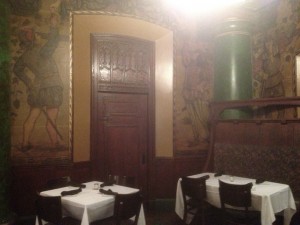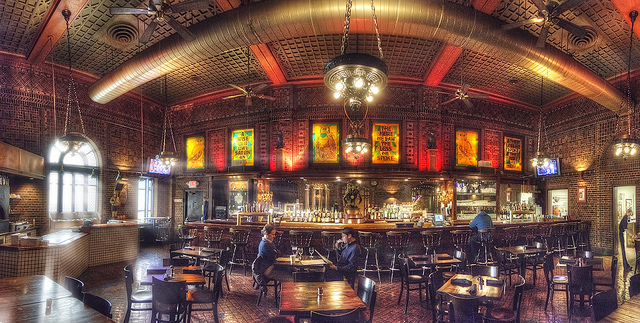Then and Now: The Owl Bar
The Owl Bar has long been a favorite after-work drinking spot for MdHS staffers. A decent beer selection, cheap happy hour specials, and some of the best brick oven pizza in town are only part of the draw though. The bar, tucked in the back of the Belvedere Hotel, has a certain ambience to which few others can compare. It’s subtly classy and charming. Maybe it’s the dark-stained bar and exposed brick that Baltimoreans gravitate toward. Maybe it’s the gauntlet of celebrity 8x10s that you pass through at the entrance. Here you’ll find Clark Gable sharing a wall with Mary Pickford, Warren Harding, and Andre Braugher. And you don’t doubt for a minute that they’ve all thrown back a few at the bar. It feels like history, well, because it is history. Six photos we’ve long admired in our Subject Vertical File have the ability to take anyone who’s frequented the bar back in time. So, let’s go. Back. In. Time.
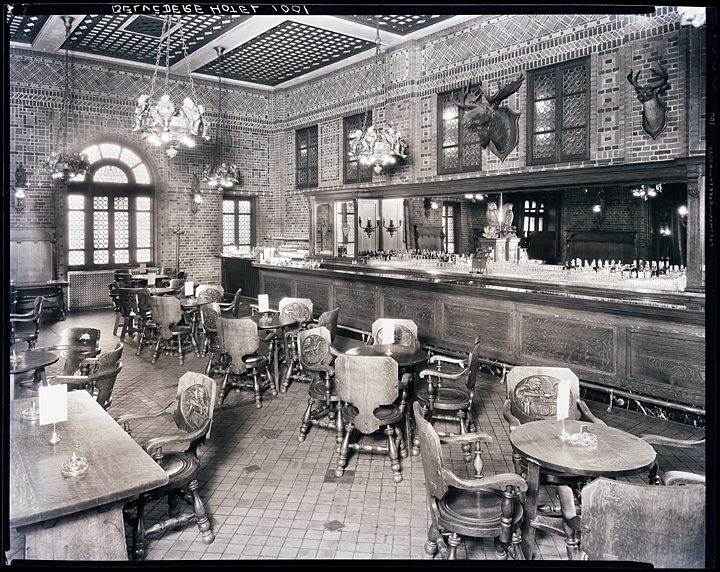
Baltimore Hotels Inns & Taverns Belvedere Hotel 1934 Interiors Barroom, Unknown photographer, SVF, MdHS.
The hotel was named after a mansion built by General John Eager Howard during the Revolutionary Period. Located at Calvert Street between Eager and Chase, it took its name from the great view of the river and the bay. The name itself comes from the Italian words for “beautiful sight.” It’s hard to imagine now what that must have looked like. The hotel, which sits west of the spot where the mansion stood until 1886, was completed in 1903 and cost $1.7 million. The bar opened on December 14, 1903. It was then known simply as the bar room or bar at the Belvedere and would not take the name Owl Bar until after World War II.
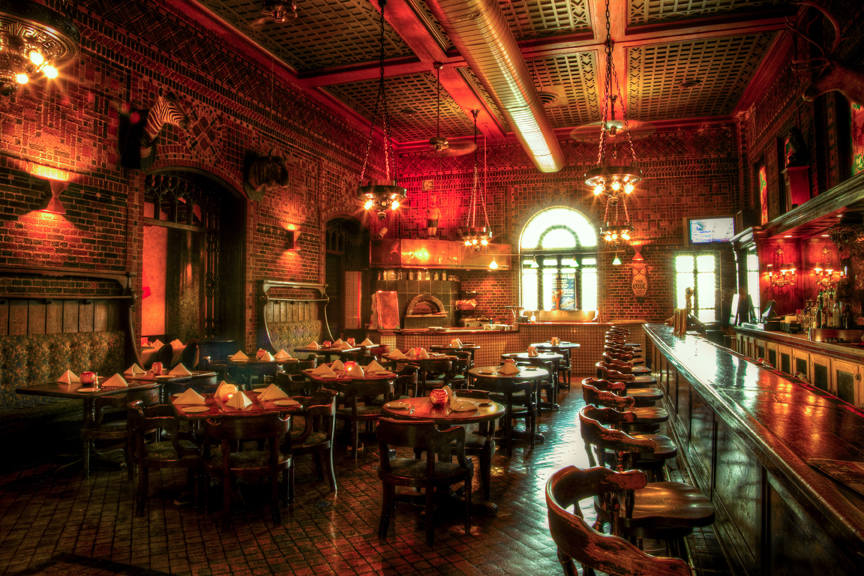
Despite still being chock full of dead animal heads, the bar is as cozy and charming as ever. The Owl Bar today. Photograph by Scott McLeod, used with permission.
Originally a men’s only establishment, the clientele ranged from high society gentlemen to workaday businessmen with some New York bookmakers peppered in. Barroom brawls were frequent and sometimes reported in the pages of The Sun. No one knows exactly when the owl theme or name set in, but legend has it that during the Prohibition Era the bar was a speakeasy where two prominently displayed ornamental owls served to tip off patrons. An eye blinked on each owl when liquor was available and the coast was clear of feds. One of the owls still sits on the bar today.
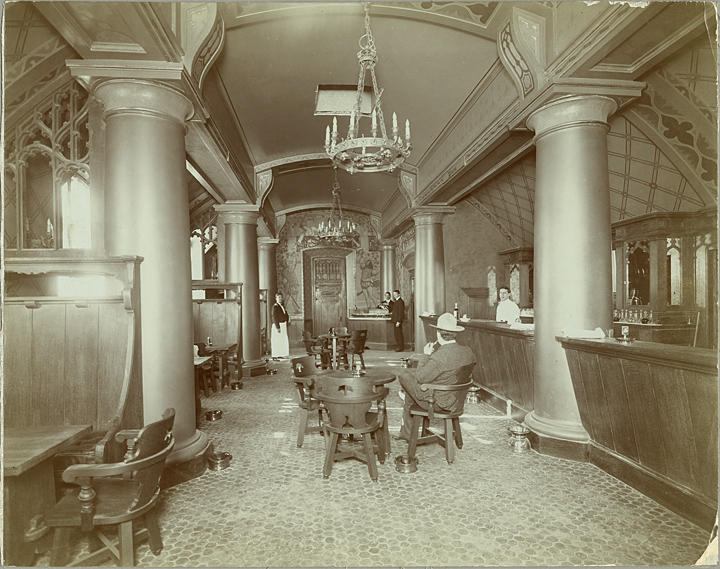
Imagine Robert Mitchum waiting to have a little talk with you in the barroom. He’s not happy that you’ve kept him waiting. Baltimore Hotels Belvedere Hotel Chase at Charles Street Bar, SVF, MdHS.
The photo above shows a room that has since been altered. Today the right side serves as a small dining room, while the left side has been walled in and made part of the kitchen. Notice the cigar counter at the back of the room. It’s since been replaced by a four-top table.
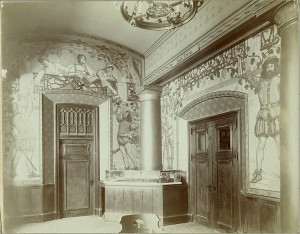
It’s hard to say if this was the bar’s entrance when this photo was taken in the early 20th century. But take a look at the cigar counter. Baltimore Hotels Belvedere Hotel Chase at Charles Street Barroom Detail, SVF, MdHS.
The dates on MdHS’s Vertical File photos are somewhat dubious. A couple of them are labeled 1934, yet could very well have been taken earlier. In Kristen Helberg’s book, The Belvedere and the Man Who Saved It, which is so far the definitive history of the hotel, the MdHS photo below on the left is labeled “The Bar Room, 1908.” We can find no clues in our records that explain how she determined the year.
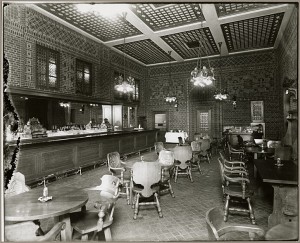
Kristen Helberg’s book dates this photo ca. 1908, but the information in our Vertical File says 1934. Who knows why? Baltimore Hotels Inns & Taverns Belvedere Hotel 1934 Interiors Barroom 2, Unknown photographer, SVF, MdHS.
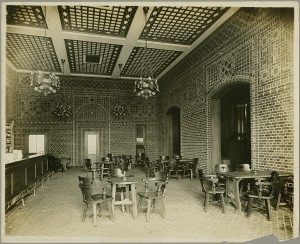
Baltimore Hotels Belvedere Hotel Chase at Charles Street Barroom 2, Photographer and date unknown, SVF, MdHS.
Regardless of the date discrepancies, the above photos work nicely with the modern day panoramic view below to illustrate the degree to which time has changed the main barroom.
Here are some details of the old bar that may provide date clues, but will certainly leave you pining for the way things once looked. If there are any experts skilled at dating cash registers from black & white photographs, please contact MdHS.
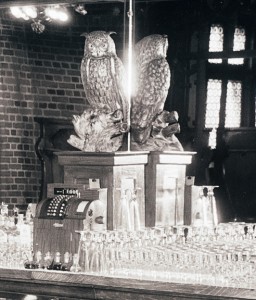
A wise owl sits atop what seems to be a simulated woodgrain cash register. Not a good era for cash registers. Detail of Baltimore Hotels Inns & Taverns Belvedere Hotel 1934 Interiors Barroom, SVF, MdHS.
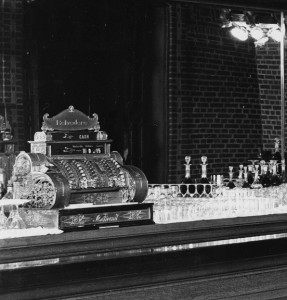
Now this is a classy register. Detail of Baltimore Hotels Inns & Taverns Belvedere Hotel 1934 Interiors Barroom 2, SVF, MdHS.
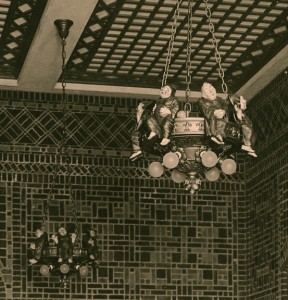
Where might the sleepy drunken chandelier gnomes have gone off to? Possibly the luckiest secondhand shop in Baltimore. Detail of Baltimore Hotels Belvedere Hotel Chase at Charles Street Barroom 2, SVF, MdHS.
Finally we leave you with a slideshow that you can call up on your smartphone while enjoying a cold one and a pizza sitting in the Owl Bar. Enjoy! (Joe Tropea)
[slideshow_deploy id=’3618′]
Sources:
Kristen Helberg, The Belvedere and the Man Who Saved It, Pumpkin Publications, 1986.
Fred Rasmussen, “Here’s a Toast to the Great Hotel Bars,” The Baltimore Sun, March 26, 2005.


